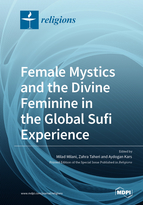Female Mystics and the Divine Feminine in the Global Sufi Experience
A special issue of Religions (ISSN 2077-1444).
Deadline for manuscript submissions: closed (10 August 2021) | Viewed by 23519
Special Issue Editors
Interests: History of religion; Philosophy of history; Sufism and Islam in the Persianate world; Mysticism; Hermeneutics; Religious Studies, Sufi Studies; Persian Studies
Interests: Persian studies; Persian language and Literature; Sufi studies; ethics Studies
Special Issue Information
Dear Colleagues,
Recent studies have broadly captured the role and significance of women in the history of Sufism. These have also addressed particular issues in relation to gender, religion, society, culture, and politics within the context of Sufi history, with some focusing on case studies from various regions of the world, including the Near and Middle East, the Subcontinent, North Africa, Indonesia, and North America. There is, however, a greater need for a specialised study focusing on female mystics and the phenomenon of the divine feminine in Sufi experience.
This Special Issue calls for papers on the proposed topic drawing on classical and modern periods. Scholars are invited to approach the topic from their own field of expertise and disciplinary background. Focused areas of inquiry into subjectivity, literary and artistic productivity, and notable figures of importance are welcome.
The Special Issue invites contributors to consider:
- The role of female mystics in Sufi circles;
- The feminine element in Sufism;
- Mysticism as feminine within Sufi context;
- Feminine representation in Sufi art (including poetry and music);
- Female mystics as spiritual guides and organizational leadership;
- The divine feminine.
Dr. Milad Milani
Dr. Zahra Taheri
Dr. Aydogan Kars
Guest Editors
Manuscript Submission Information
Manuscripts should be submitted online at www.mdpi.com by registering and logging in to this website. Once you are registered, click here to go to the submission form. Manuscripts can be submitted until the deadline. All submissions that pass pre-check are peer-reviewed. Accepted papers will be published continuously in the journal (as soon as accepted) and will be listed together on the special issue website. Research articles, review articles as well as short communications are invited. For planned papers, a title and short abstract (about 100 words) can be sent to the Editorial Office for announcement on this website.
Submitted manuscripts should not have been published previously, nor be under consideration for publication elsewhere (except conference proceedings papers). All manuscripts are thoroughly refereed through a double-blind peer-review process. A guide for authors and other relevant information for submission of manuscripts is available on the Instructions for Authors page. Religions is an international peer-reviewed open access monthly journal published by MDPI.
Please visit the Instructions for Authors page before submitting a manuscript. The Article Processing Charge (APC) for publication in this open access journal is 1800 CHF (Swiss Francs). Submitted papers should be well formatted and use good English. Authors may use MDPI's English editing service prior to publication or during author revisions.
Keywords
- Sufism
- Globalism
- history
- culture
- art
- mystical experience
- divine feminine
- female mystics






